Chris Jones's Blog, page 13
December 15, 2017
Creating the magic of the Nativity… on a shoestring
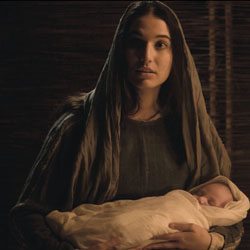
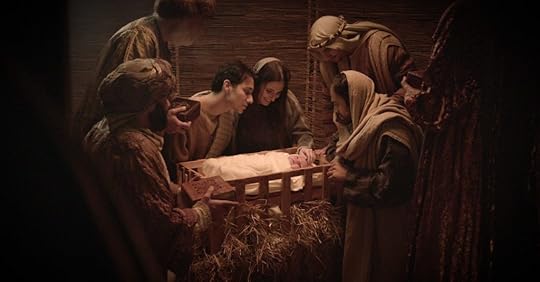
I asked DP Don McVey to share how he lit the recent series of short Xmas films that I directed – essentially recreating both the first century nativity as well as a modern day Xmas, all on a micro budget. Here’s what he just posted for us…
I was recently DP on a series of short Christmas films for director Chris Jones and the London Screenwriters Festival team. I planned on doing a detailed lighting breakdown of all the scenes, but we moved SO fast during the shooting that I never had time to take detailed notes or even photos of most of the setups.
Instead, I’m going to write about how I approach lighting a shoot like this. Specifically one that is very limited by both time and budget. I wouldn’t exactly say we had a ‘shoestring’ budget. I had a gaffer with a small van of lights and an AC to help me out. But for the quality we wanted in the end result, it was a tough shoot!
*Notes from the grader at the end of the blog.
Here’s PART 1:
I didn’t do any pre lighting plans on paper as I’ve worked with Chris before and I know he likes to move fast and keep options open. Block. Light. Shoot.
So I’m going to go through some scenes and try to give examples of how we squeezed everything we could into the tight timeframes. My gaffer had brought the following kit:
1x 2.5HMI, 1x joker bug 800, 2x 2k blonde, 2x 1k, 2x 650, 2x 300, 1x dedo kit (3 head), 1x 4’4 kino, 1x 2’4 kino. – And I’d brought my Skypanel RP60 and Cineflex light.
I knew that Jazz would be doing pretty much all the heavy lifting, so I wasn’t looking at these lights thinking ‘lot to choose from’, I’m thinking, ‘what’s the least amount of stuff we can get off the van? How can we have a small footprint on the sets? How quickly can we move lights? Can we re-use lights already setup from one scene to the next? Something important I’ve learned is to understand where to compromise depending on the needs of the shoot. It’s not about ever being sloppy. It’s about balance.
(All shot on Fs7, Slog3, Cine EI with Veydra Primes)
The Car Sequence
There are many ways to light a car, but the absolute simplest way to do this was to sandwich them with light.
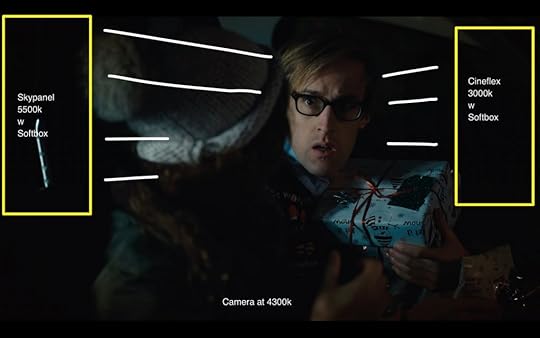
My thinking was there was some kind of cooler light on the street and a warmer glow coming from the house. In this scenario does it matter what the street source is supposed to be? I wanted them downside keyed, while still keeping it cosy and intimate. This was the last scene of day 1. It was late. We had an early start the next day and long drives home. It was freezing. The scene is short. So I’m lighting with all that in mind to just get what we need from the scene.
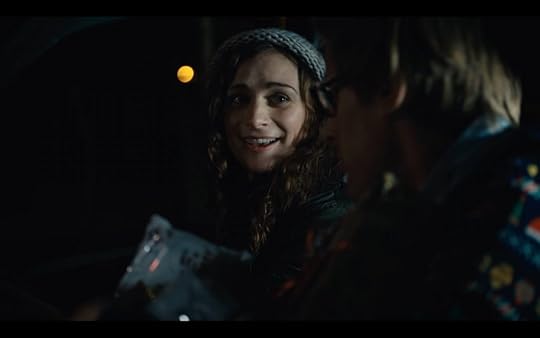
The Hallway Sequence
This is an example of a scene that could become very tricky ‘if’ you over think it. It’s exterior to interior and a group of people, all facing in different directions. On another production, we might relight every angle, but what we wanted to do here was ONE lighting setup to rule them all.
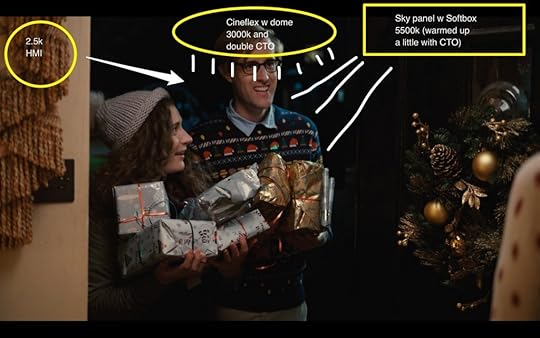
*correction. Single CTO above. Don’t want to redo the drawings!
I’ve got a Skypanel outside, high up and right against the wall pointing down. This is purely to give them a little edge light at the door. An HMI is hitting through the trees at the back to show up the car from previous scene and also give some background separation. But the star of the show is my humble Cineflex panel (review here). We boomed that out on a double C-Stand arm, with the dome diffuser. This keyed all the actors with even soft light. We moved it around a little for the different angles, and had to use some bolton to flag it off the walls a bit, but this was a case of simple tweaks. So once we had this scene lit, we blasted through it!
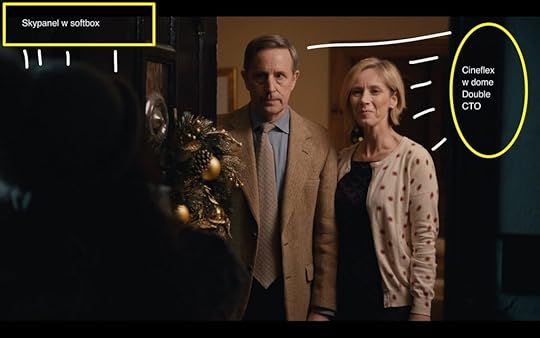
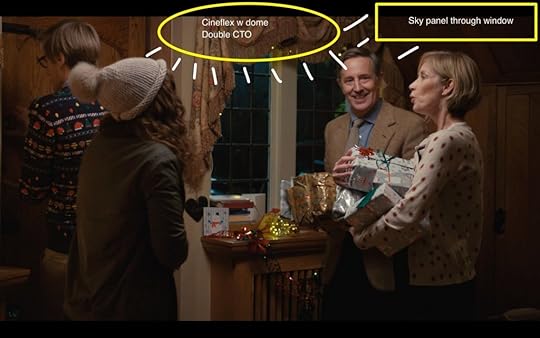
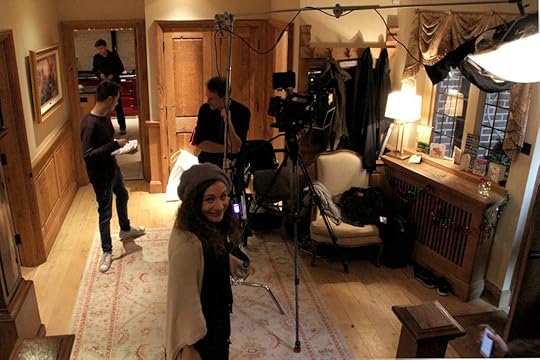
The Dining Room Sequence
The dining room is another scene that could have been tricky.
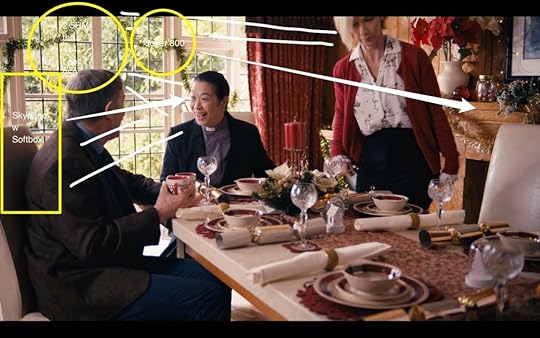
Because of the layout, we were pretty much forced to be pointing out windows. This meant I needed some lights with a bit of punch to balance it all out. I have a fairly simple ‘formula’ for lighting day interiors. Big soft key, hard accents. Off course this is about style and tone, but for something like this, a Christmas comedy, I can go for nice natural lighting. For all the dining room setups, I was using the 2.5k HMI (usually through 4×4 diff), a Joker 800, and the ubiquitous Skypanel.
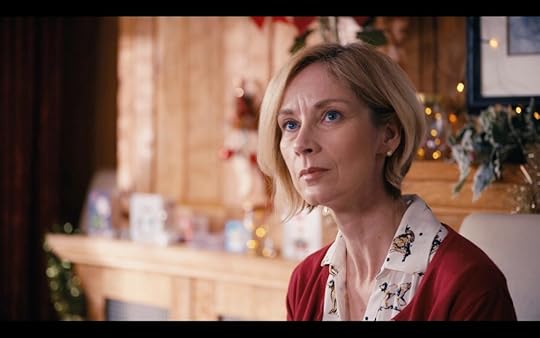
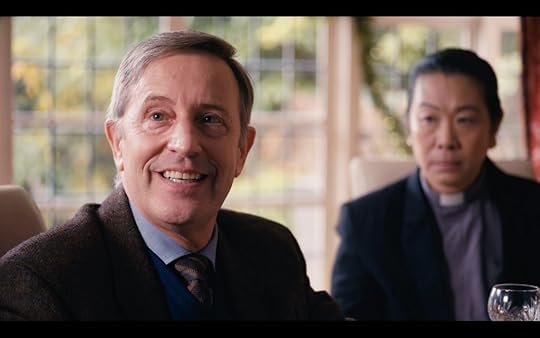
Grabbing What You Can
These are a couple of quick examples of just getting what you can with what you have to work with. The below shot is entirely natural light. This was a case of noticing that the sun just happened to be doing my job for me – and we grabbed it!
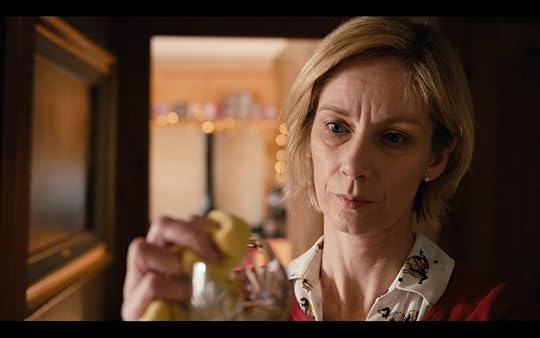
And this was a scene shot at night (November has very little daylight in the UK, and was another reason we were so pushed all the time). Chris needed to get this scene and I knew I couldn’t light the entire kitchen in time. It would have been very hard to keep it all looking natural. So we used the door as a frame to hide the fact it was night. Now we are lighting a tiny area. Skypanel key and a Joker 800 down the wall. Job done!
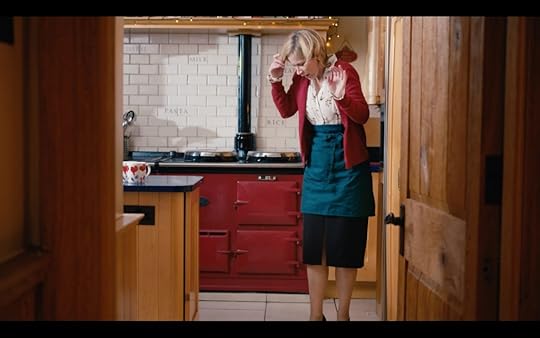
The Nativity
One of the last things we shot was the Nativity itself. We knew it was coming, and knew we had to turn a little pool house into a 1st century barn – full of actors! It was something we kept laughing about throughout, but inside I was crying a bit 
December 12, 2017
Episode Three of our Xmas Film lands… watch here
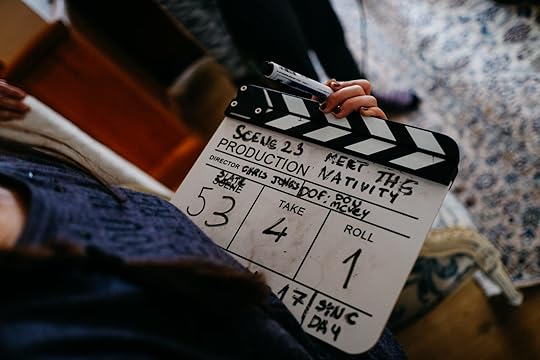
Episode three of our Xmas Nativity film that we made for Speak Life has just landed. You can watch it above.
Onwards and upwards!
Chris Jones
My movies www.LivingSpiritGroup.com
My Facebook www.Facebook.com/ChrisJonesFilmmaker
My Twitter @LivingSpiritPix
Sign up to my mailing list for updates on events, books and free film making tools
December 8, 2017
Filmmakers, spend one day shooting and be part of a global feature film

Impact50 is the latest feature film project from Create50 whose last film, 50 Kisses brought together several thousand creatives, writers, actors and filmmakers globally, the feature film ending up on the big screen and also entering the Guinness Book of records!
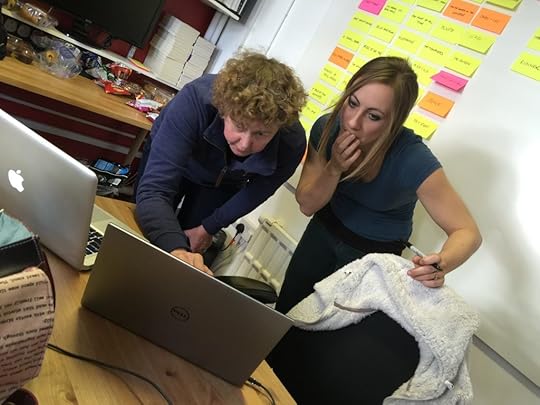 How does it work?
How does it work?We have 50 cracking scripts, all around two pages long.
Choose one (or more if you like), option it from us for £7 to formally enter the process, make it, upload it to the site, get peer review, re-edit if you like, leave feedback on others films and become part of an extraordinary movement.
The project has been gaining momentum and in the new year will begin to expand rapidly as we approach the closing deadline at the end of April.
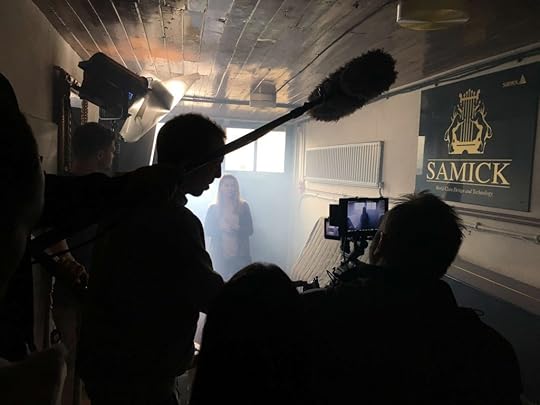 At that point, the judges take the best films and we make a feature film from them. That film will then be pushed onto as many platforms and channels as we can reach – including online, theatrical, TV and festivals.
At that point, the judges take the best films and we make a feature film from them. That film will then be pushed onto as many platforms and channels as we can reach – including online, theatrical, TV and festivals.
You will always own your film and can do anything you want with it beyond the Impact50 initiative. We want to help platform you, your work, your team and the screenwriters involved.
Watch the premiere video from the 50 Kisses Awards HERE to get a sense of what will happen.
So it’s really easy… Choose a script, make it with whatever resources you have available, and send it in. Get feedback and leave feedback and GROW in experience, contacts and possibilities.
The real gift in the Create50 experience is the experience and collaboration that comes from being part of the process.
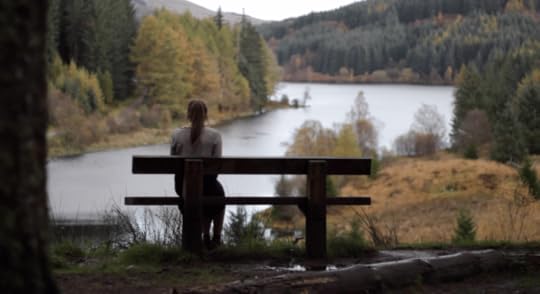 Many long term collaborations evolved out of 50 Kisses and we can already see the same thing happening in with Impact50.
Many long term collaborations evolved out of 50 Kisses and we can already see the same thing happening in with Impact50.
Check out the site HERE.
Read the scripts HERE.
Watch some of the films already submitted HERE.
Read the rules and guidelines HERE.
There really is no reason not to be part of the process as most scripts could easily be shot in a day.
Get involved and plan for success in 2018! Go to www.Impact50film.com now.
Onwards and upwards!
Chris Jones
My movies www.LivingSpiritGroup.com
My Facebook www.Facebook.com/ChrisJonesFilmmaker
My Twitter @LivingSpiritPix
Sign up to my mailing list for updates on events, books and free film making tools
December 5, 2017
Episode two of our Xmas web series goes live with 20k views!
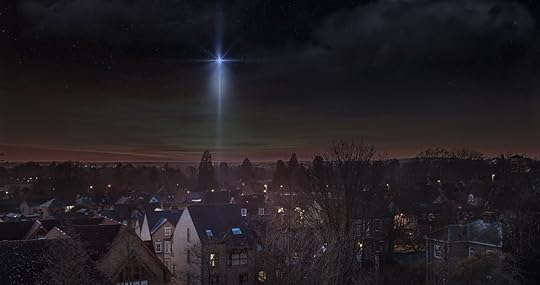
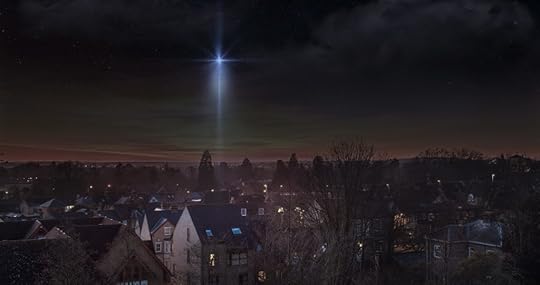
Last week we premiered the first of four Xmas films we made, that film, episode one, is about to sail past 200k views.
Here for your pleasure is Episode Two, The Girlfriend. Expect a blog soon by DP Don McVey about how we created the Nativity in the most extraordinary of limited conditions.
Onwards and upwards!
Chris Jones
My movies www.LivingSpiritGroup.com
My Facebook www.Facebook.com/ChrisJonesFilmmaker
My Twitter @LivingSpiritPix
Sign up to my mailing list for updates on events, books and free film making tools
November 29, 2017
We made an Xmas movie and you can watch it now…
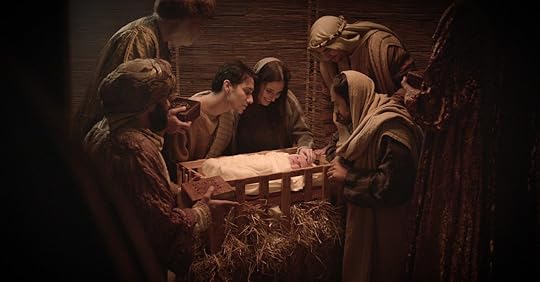
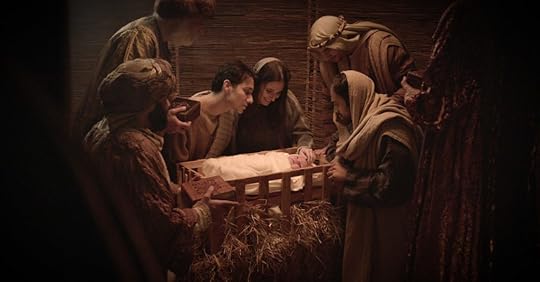
Over the last few weeks we have been making a Christmas film, commissioned and funded by Speak Life. It’s kind of what would happen if Meet The Parents bumped up against actual first century Nativity, set in Richard Curtis World of London.
Episode one just went live (watch on this page) and has at this point over 80k views in 24 hours.
I will be posting more about what we learned making this film, but for now, sit back and enjoy episode one.
Onwards and upwards!
Chris Jones
My movies www.LivingSpiritGroup.com
My Facebook www.Facebook.com/ChrisJonesFilmmaker
My Twitter @LivingSpiritPix
Sign up to my mailing list for updates on events, books and free film making tools
November 28, 2017
How Filmmakers Consistently Climb Mount Impossible… Four strategies to get you on set
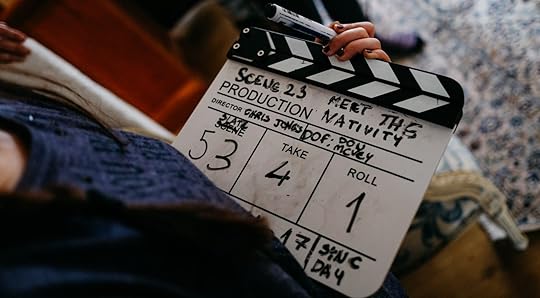
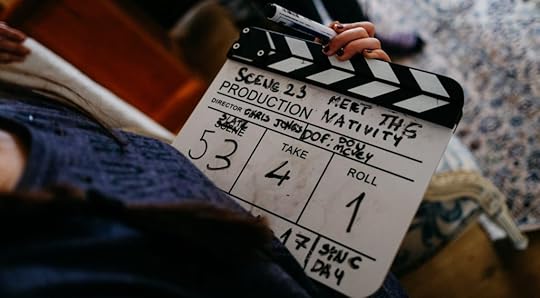
Every time I have embarked upon a major project, bee it a book, web initiative, festival or feature film, I choose not to engage with the enormity of the project until I am almost there.
You see, if I think about it too much, I will conclude that it’s quite simply impossible.
And in many ways, these endeavours are impossible. Or at the very least, unreasonably dominating on our lives.
The narrative (that I invent and tell myself) in my head is NOT that it’s ‘impossible’. I tell myself that it IS possible. I don’t know exactly how. I don’t have it figured out. But others with less money, talent and resources have done it. So I can too.
And it begins. Then and there. A decision is made.
I then follow very quickly with important first steps.
And it’s those first steps that are so important. If you begin the journey with the mindset that you are attempting the impossible, you will find that somehow people can smell it and those first few steps will fail. On the other hand, if you just focus one what IS possible, you will likely find success very quickly. Again, people can smell someone on a mission who is DOING IT.
And after just a few small steps toward mount impossible… you will find it’s quickly become mount inevitable.
Possibility becomes certainty and human beings LOVE certainty.
Focus… Instead of looking up at the distant impossible challenge, successful filmmakers know where they are headed (roughly) and just focus on the next few steps, the next ridge, the next pass, the next river to cross… They will deal with the next challenge when they get to it… But ALWAYS headed in the right direction. Where focus goes, your passion and energy will flow. Focus on the immediate next steps and ensure you’re headed in the right direction by occasional glances upward. Next week will take care of itself next week.
Team… Success filmmakers surround themselves with a small but passionate team of believers. Not blind believers, pragmatists. Two or three focussed dedicated people can make miracles happen. There is no room on this expedition for doubters though. So if you have a doubter, leave them behind or choose to spend less time around them (if they are a relative or close friend). We are the five people we hang out with. Hang out with the dooers, dreamers and believers.
Execution trumps planning. Successful filmmakers do it now, not one day someday, that way leads nowhere. Yes we need to strategise and plan, but so much of that can be done on the journey. Nothing will keep you up writing your script than the knowledge that it will be shot in seventeen days. Momentum. Plan less, do more.
Joy. The process should feed the soul. I often say that the worst day filmmaking trumps the best day stacking shelves at Tesco. If you feel this way, you will be infected by the disease that is filmmaking and there is no cure, just another film to make. Ultimately, the only point of life is to experience joy and bliss. For some that can be found raising a child, standing in a rain forest… or calling ‘Action’ on the first take of your next film! Find your bliss.
So don’t worry about not knowing enough people, not understanding the process, not having any kit, and generally feeling like a fraud… Do it! We are all frauds and bluffing it anyway. Even those who look like they are not. They are just very good at it.
We have one life to live, and so many films to make.
I will see you at your premiere!
I just shot my first comedy too(as I haven’t done comedy before and it’s not my forte (this was a whole new Mount Impossible for me). It’s called Meet The Nativity and is about to sail past 40k views within 24 hours. You can watch Episode One HERE.
Onwards and upwards!
Chris Jones
My movies www.LivingSpiritGroup.com
My Facebook www.Facebook.com/ChrisJonesFilmmaker
My Twitter @LivingSpiritPix
Sign up to my mailing list for updates on events, books and free film making tools
November 24, 2017
‘Withnail and I’ Script to Screen with Bruce Robinson #LondonSWF
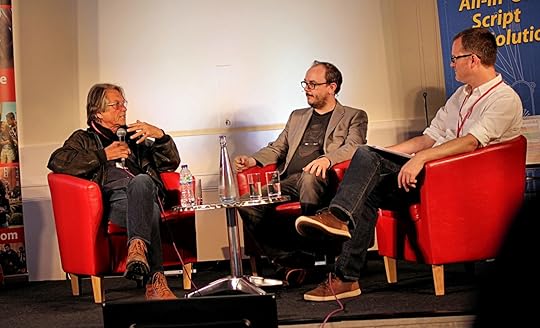
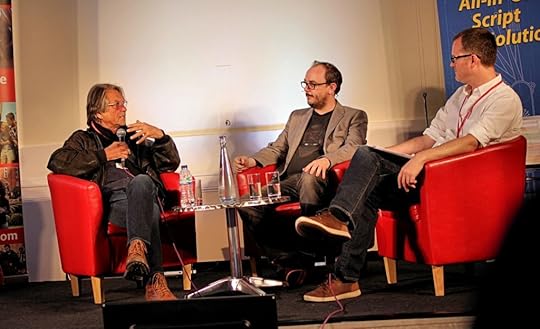
Bruce Robinson started out his industry life as an actor. Having trained at the Central School of Speech and Drama and acted as Benvolio in Franco Zeffirelli’s ‘Romeo and Juliet’ he found himself broke and living in a house with one light bulb which he would take from room to room and mostly use while sitting by the oven, the only heat in the place. With time on his hands and enduring very real hardship he found himself one snowy day down on his knees in his ‘big room’ begging the gods to save him from his terrible predicament of being an actor who couldn’t get an acting job.
The absurdity of his desperation was not lost on him and he then and there began writing a fictionalised account of the life of himself and his friend Vivian (MacKerrell) on an old Olivetti typewriter. The story, initially intended to be a novel, got passed around friends and one person with a wealthy relative who suggested it could be a film. It then took years to get made. In the meantime, he was sent along to David Puttnam who thought he could write and got him a writing job that paid eight grand a year. One of the things he wrote was award winning adaptation, ‘The Killing Fields’ which scooped him, among other trophies, an Oscar. Meanwhile ‘Withnail and I’ was still popular and passed around by his broader acquaintance until it finally got made, it’s charm eventually becoming the cult legend we know today. Sitting down to watch the film with us he shared his memories and his process about this much loved work and creation in general.
Writing Quotable Dialogue
Rewrites on Withnail, Bruce tells us, were a pain but having been paid, he had to get on with it. The easiest part for Bruce is the dialogue, he finds structure much harder, but dialogue, he says, is still hard. As many writers do, he goes through things he might say in a scenario and then adjusts it and other dialogue to make it all work better. The tea room is one of the oft quoted scenes, he tells us, and was one of the few times that even the actors laughed at their own lines. Richard Griffiths also corpsed a bit on the ‘toilet trader’ line. Watching the film in the room with Bruce he charmingly laughs still at jokes he must now have heard thousands of times, the contagious wit of the lines working their magic even on their creator.
Making Scenes Visually Relevant
The Uncle Monty seduction scene is tremendously visual and what Bruce calls his ‘stage directions’ in this and his other films he writes to be as detailed as the dialogue. He doesn’t like the ‘we see’ type of screenwriting or ‘technical crap’ he suggests leaving the camera to the director and focusing description to reflect the tone of the scene. Don’t squash funny lines with dull description he tells us, find a good way.
Breaking Rules if it Works
‘Withnail broke all the rules, it’s a five act structure, Bruce tells us but from the enduring popularity of the film, it’s clear that it worked for the journey of these characters. The ending Bruce says was adjusted from the original to be less harsh than the initial suicide scene that was intended. The character identity was an actor so having him play Hamlet was more moving and he in fact changed the Hamlet lines because Withnail only really loved himself.
Working on It
Bruce yaks and yaks to himself until he hits on something that sounds alright, might be dialogue, might be story ideas. He researches. He worked with a professional researcher for his Jack the Ripper book who got him material that he couldn’t have found alone. He strongly recommends that if we get a chance to work with a professional researcher we take it. He’s interested in getting things right and wants the truth on the page. His work is visceral to us perhaps because he brings a truth to the screen whether that’s the truth of his conviction or because he’s telling the truth of life. The scene where Withnail drinks lighter fluid was a scenario that happened for real which was not amusing at the time. Vivian went blind for two days. The seduction scene with Uncle Monty was loosely based in his experience acting as Benvolio when Franco Zeffirelli took an aggressive shine to him but he wanted to make Uncle Monty very sympathetic and that’s a different sort of truth rooted in who that character was.
Watching ‘Withnail and I’ in any room full of people is always a great pleasure but watching along with Bruce Robinson was an experience to treasure. A born entertainer who tells decades old stories as if he were divulging them for the first time. Under his coat of genuine charm is a consummate professional who values his own learning and experience and doesn’t take his gifts for granted. If he gave us one valuable thing (he gave us many) by visiting the festival it was to encourage us to work on our own value as creators. Thank you Bruce Robinson for sharing ‘Withnail and I’ with us.
November 19, 2017
Big Vision: How To Attract Prolific Producers To Your Script #LondonSWF

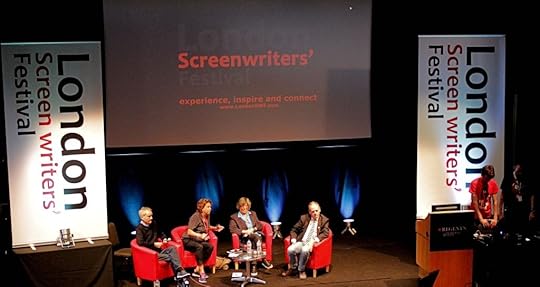
With long term careers spanning decades in the industry, producing heavyweights, Ruth Caleb, John Lloyd and Tony Garnett joined TV legend Barbara Machin at this year’s London Screenwriters Festival to discuss how prolific producers select their ongoing work. These producer’s ‘Big Vision’ has broken the mould of established drama time and again, moving drama evolution forward through the decades. How we might attract such heavyweights to our own work often begins with understanding mindset of people who produce outstanding content and what they look for as they add to their body of work.
Few Productions Stand Out
Tony Garnett who’s been producing since 1968 and worked in the industry as an actor for a decade before that, quite rightly points out that there was never really this ‘Golden Age’ of production that people always reminisce about. Then as now, only a few shows stand out as being truly great. Work that resonates has always been rare compared to the bulk of production.
Producers Follow Their Vision
Tony wanted to use the screen for a socialist revolution, ploughing his furrow with work that reflects his ideals and making stories that are important to tell. Doing this he’s built a lengthy career that spans almost half a century. For Ruth, after rising to being the BBC’s first female Head of Drama at BBC Wales returned to producing still felt she had more of her own furrow to plough and wanted the freedom to invest more heavily in the work she wanted to see created, she stepped down from Head of Drama to create her own work again.
Producers Hone Work Through Development
Ruth chose to undertake a unique style of project with a documentary director who wanted to create a drama around relationships using real people as actors. The BBC, horrified that they were planning to improvise wanted a writer on standby in case it all went wrong. The team Ruth brought together found real people with a great story but ultimately filmed it with professional actors who could serve the story best. The resulting, redemptive docudrama ‘Nice Girl’, crafted by Ruth and director Dominic Savage from the story discovered through their atypical development was nominated for several awards and won Dominic the BAFTA TV Award for Best New Director.
Work Evolves Over Time
When approached to do ‘Blackadder Goes Forth’ John Lloyd thought the setting unfunny for this comical franchise that had broken the sitcom mould. The idea though had just two sets which meant it was cheap to produce so he rolled with the idea gaining himself the moniker ‘Mad Jack’ from his team as his notes exceeded the length of the scripts! His diligence and that of the other creators won out though and the comedy reached new levels of relevance. Ben Elton receives many letters from old ladies who lost husbands and sons in the war thanking him for understanding and the series is still shown in schools as a talking point around study of the war. Good producers, John tells us, make ideas work the best way they can and hopefully make shows that have depth and longevity. The momentous ending of that drama came from a disaster on set that was solved in the edit room and became something greater than intended. Sometimes, John says, you get lucky so you never give up. ‘Blackadder Goes Forth’ won BAFTA awards for Best Comedy Series and Best Light Entertainment Performance and the RTS Television Award for Best Situation Comedy.
Great Work Is Only Great if it’s Made
When Tony got bored of producing TV’s cult hit ‘This Life’ he declined the BBC’s offer to renew and surprised, but respectful of his experience they asked him what did he want to do if not that? He told them he wanted to show a run down council estate as a social commentary. In an ideal world, a set of social workers would have been the perfect story device to take characters into those settings but Tony knew that social workers would be viewed as dull and be a tough sell to get commissioned so he did social worker stories but with cops instead of social workers. TV loves cop shows. He perpetuated what he calls ‘Trojan Horse Drama’, the show you want to make in the clothing of a show commissioners want to do. ‘The Cops’ was commissioned and won the BAFTA Best Drama Series award three years running.
Craft is Key
The producers final words of advice to us are about investing in what you create. To achieve one of the shows that really does stand out, Tony is a great believer of research, knowing about what you are writing so you don’t write rubbish. Films are about people living in circumstances and audiences should be engaged with the people. How you open a show is very important, if you don’t get them by the balls, then, he says, then you don’t get them. Technology makes shows look better these days but the quality of writing and quality of what you’re writing about doesn’t change. It’s harder now because TV is so commodified you have to find your audience, even with a Trojan Horse Drama if you need to. John believes in being current, people don’t think long term anymore, for projects like ‘Spitting Image’ it was too hard to get ‘Spitting Image’ done and has proved too costly to get it back despite the fact that people miss it. Ruth knows that if creatively you want to do something you may have to knock on a lot of doors but it’s worth exploring. Find innovative ways to tell the story you want to tell and push forward with your vision.
It’s clear from this talk session that prolific producers bring their own vision and talent into being through projects every bit as much as writers and directors do. Their careers are long and they look always to find the work that is resonant and viable to produce for the current times, rather than merely perpetuating work they’ve produced before. These extraordinary contributors to the industry have a lot to show us about enabling work that matters, for it is perhaps drama that resonates most loudly for the current time that alsoresonates forward into the future making those shows and films that become the ones that we laud and remember.
November 2, 2017
Die Hard Script to Screen with Jeb Stuart #LondonSWF
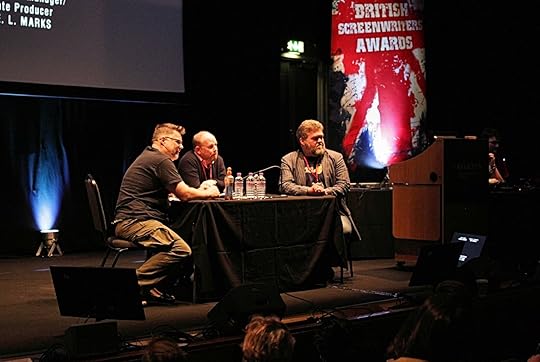
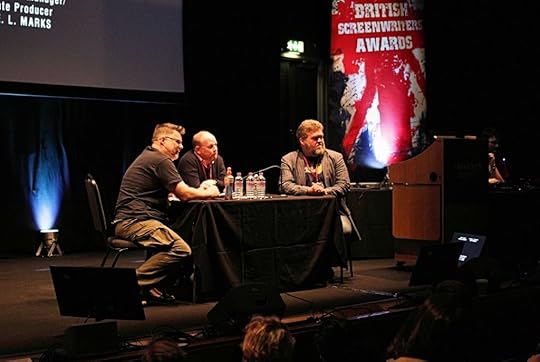
There is nothing quite like the London Screenwriters’ Festival live script to screen sessions. To get to sit together as a community and watch our favourite films alongside their film legend creators is a treat indeed. When they tell us in person just how it was done it’s also a huge learning experience if one can suppress awe long enough to take it in.
Die Hard is an action movie that’s not only is a great film in and of itself but which defined the genre for so many films that came after and solidified careers with it’s enduring success. Now a veteran action screenwriter Jeb Stuart joined us to talk us through the evolution of this, his first action screenplay produced, and the writing choices that made it work so very well on screen.
Adaptation is Improvement
Die Hard was an adaptation of Roderick Thorp’s novel Nothing Lasts Forever. A darkly cerebral book sequel, it featured a 65 year old protagonist and his 40 year old daughter both of whom die at the end and was proving too depressing for studios to green light. Under some financial pressure at the time Jeb had looked for some extra work to span a five week window of non-exclusivity in his then Disney employment contract and he was hired to try to breathe some life into the Fox property with a new draft. Finding it initially frustrating Jeb argued with his wife about having to go back to work at the studio one evening. He took off from home without apologising for being in the wrong before narrowly avoiding what could have been a fatal car accident when a fridge box fell out of a truck into his path. Fortunately it did not contain a fridge and a flattened box was the only collision, but it did give shaken Jeb an idea of how he could stay close to the source material while making the story more redemptive and heroic. Essentially it would be about a younger man, who didn’t apologise to his wife when he should have and then must save her from a bunch of ruthless terrorists to have any chance to make amends. Jeb wrote the first 40 pages that night and when he turned in the full draft in on a Friday it was green lit that weekend.
Work Your (real or imagined) Location
The Nakatomi Plaza location is actually the Fox Plaza building in Los Angeles, home of 20th Century Fox which stands adjacent to the Fox lot and at the time of writing was itself under construction. Knowing they were planning to use it as a set, Jeb made friends with the building manager who showed him things about the building and construction works that gave him lots of great ideas. He took pains to set out the location geography early in the script so that new locations weren’t introduced at the end purely for the convenience of finale aesthetics but were rooted and established within the story structure.
Suspense is Action. Character is Suspense.
Though lauded as a great action movie Jeb points out that there’s really more suspense in Die Hard with just a few action pieces. A key note is that suspense only works if you like the character. Without properly building a character the humour doesn’t work, suspense doesn’t work and how a character is built can affect who is cast in the role and the line delivery. If your characters don’t matter you’ll be fired and they’ll swiftly become another writer’s characters. Often Jeb writes a whole scene and lops off the first third leaving the actors to sell it from that point without flabbiness. Unnamed extras must also be characters that matter to some extent. Two nice moments in Die Hard are in a building assault scene where one SWAT guy scratches himself on a rose bush as they move in and a terrorist ducking into a lobby kiosk for concealed shooting vantage, idly reaches for a candy bar in the silence that awaits the attack. Tiny things you don’t pay attention to but subliminally show these generic characters are real people with cares and woes who may die in the coming action. Jeb tells us, you have to stagger tension, add humour and new information, create ledges for an audience to rest their anticipation before building it up again. Not every ledge works for every story, but when action films become comedic or terrifying you’ve invested an audience in your action.
When To Give It Up
When you give up your script, Jeb tells us, it becomes somebody else’s script. It becomes 120 professionals’ script and after the challenges of shooting can look very different to the story you’ve originally envisioned, but those professionals add huge value at every step. Initially screenplays are typically read by one important reader so you can’t allow plot holes that they won’t understand but when more voices get involved things can get malleable again. Moving into the third act there are all sorts of threads that get created and have to be wrapped up. One of the notes that came down on Die Hard was that if they were spending that much money on a movie then the top of the building had to blow up for an exciting visually dramatic finale that would draw sales both domestically and from non-English speaking markets overseas. Director John McTiernan thought with the financial element it should be a heist movie. The two notes led to the dramatic plot twist in the terrorists motivations which neither we nor the protagonist initially see coming. Letting go of the original plot plans allowed for this great development.
Why Die Hard IS a Christmas Movie (and why timing matters)
While the events of the novel take place at Christmas the adapted movie needn’t have and they debated whether it should. One thing decided them and that was that for plot reasons Jeb needed to empty the building of everyone except for those at the Nakatomi party. Christmas was unique and perfect timing for that circumstance to occur and so Die Hard committed itself to being a fully fledged Christmas Film and we have that from the writer’s mouth. The season fortunately also works well with the main emotional drive of the movie, that of family and reconciliation and yes, miracles!
October 26, 2017
5 simple yet essential Drone Shots you must master for your shorts and features

By Paul Archer
In my experience with drone cinematography I have noticed that there’s a standard set of moves which deliver the best cinematic results.
These 5 simple moves should not only be the basis of your drone shots, but they can also be used successfully in professional creations.
Before I list these for you, let me give you a small bonus with 3 tips to help you get better shots:
Always cut the video when the drone is already moving – There are exceptions to this rule, but most of the time you want to start the cut while moving, either the drone or tilting the camera to create a more powerful effect.
Using custom flight modes at the right times – By custom flight modes I mean things like “orbit flight“ and waypoint flight modes present in most camera drones these days like DJI Mavic or Phantom 4. Don’t try to do a circle on your own when you can do a perfect one with the tools available to you. Same way, you can set some waypoints and then control the camera movement and simply focus on that. Don’t make things harder for you! (It happens often for me to forget)
Move/tilt smoothly – Moving your drone smoothly and tilting the camera without sudden interruptions will allow you to record more usable footage, even though you may not have planned to do it.
Bonus tip: When returning home with the drone, try to still record and capture some basic shots, as you may just need them later (there’s never enough footage).
I strongly recommend checking out my guide on how to pick a camera drone if you want to get the proper quadcopters to do any of these shots.
The 5 drone shots you need to know
The Tilt Reveal
This is probably the simplest shot most people recognize, but I’d say the most effective one.
How to do: Tilt your camera up with the drone either moving forward, backward or sitting in the same spot.

This move can be used successfully for certain introductory reveals, for example:
Flying above a desert and then tilting up only to reveal a beautiful city landscape.
Flying above a lake (close to the water) and then raising the camera to reveal the mountains surrounding it.
Having the camera facing forward, tilt it down and reveal a beautiful sight (like a port or a boat, or a certain building).
The overtake
This move is mostly done to put an emphasis on depth and is usually used with a subject in front and a landscape in the background.
How to do: Start behind your subject of choice and fly past it to reveal the background.

There are many different variations you can do with this, like combining it with the previously mentioned “tilt reveal” and create an even stronger focus on the background or subject.
Ideas to use it:
Fly in front of a music band while going towards them while going towards a background object like a mountain, for example. This will make the Foreground subject (the band) seem like approaching very quickly while the background is still in its full glory.
Fly towards the side of a lighthouse and ho past it just to reveal a beautiful rocky sea side.
Fly towards a girl (and slightly go above her) while the camera is level with the ground and when almost above her, tilt the camera down and
The Side Follow
How to do: Pretty self-explanatory: you follow your subject from the side (although this has many variations)
The side follow is usually used when you want to focus on the actions of a specific character or create a stronger feeling of movement.

What concrete situations can it be used in?
Introducing a character or a car– Let’s say in a movie where the subjects starts running along a road and enters the frame through the left while you’re slowly moving the drone towards his direction. Same can be done with a car or any other moving object. You can also make the subject enter from the right side of the frame while he’s running.
Keep the subject in the center and fly the drone at the same speed as the subject. This helps to put the spotlight on the subject and his relation (or isolation) with the environment.
Reveal a foreground subject – fly the drone from left or right until the subject (human, monument, tree, etc.) comes in the frame (keep the drone close to the subject but far from background (while keeping everyone safe).
Tip: It’s probably not a good idea to fly towards a fast car from the direction it’s coming, because it won’t stay much in the frame.
The “side follow” can be also made with automatic tracking options in many modern drones (I would think Mavic pro) and it will automatically follow the subject sideways (and not only).
The helix (and orbit modes)
This is probably my favorite, yet the most complicated to do manually.
I know I said these will be simple shots, but don’t kill me yet.
There is a simple version of this that can be made automatically with most drones over $500 these days.
How to do: Rotate the drone around a focus object while raising its altitude.
How do you rotate the drone around an object smoothly, though?
As said before, you can use the “orbit around” flight mode that can be found on most drones and then just press the left stick up to raise the drone while it’s doing a perfect circle around a target.
Where can the helix and orbit modes be used:
Real estate – when trying to present a house from more than one angle. This will create a feeling of 3D and will keep the subject in focus.
You can do the helix move to reveal something over a mountain. Start with the drone oriented parallel with the mountain and go around and above it to reveal what’s behind.
Rotate and reveal with a skyscraper/ tower and show the city/landscape behind it. Make sure you respect regulation, because flying in most big cities is forbidden.
Bird’s Eye
This is probably the best way to let the audience know the shot was taken with a drone. Not only that, but you can create amazing composition with this shot (both for photo and video).
How to do: This one is truly simple, all you have to do is go above a subject and orient the camera down. But is it that simple?

How can it be used:
Start low above a subject and raise the drone (you can also rotate it slightly without creating dizziness)
Reveal some persons walking on the beach (start by following their trails from above) and make sure to fly when the sun is low in the sky to also capture their shadows on the ground.
You can use this to reveal landscape, either by going straight up, or in any direction and maybe put some text over it.
These being said, the more you go out in the field and test things, the more you’ll learn.
So get a bunch of batteries, a few friends, and start practicing these 5 drone shots until it becomes your second nature.
 Paul Archer
Paul Archer
I love quads and UAV’s in general. Being the founder of DronesBuyer.com, I plan on making it the go to place for most things drone-related. I have still much to learn and can’t wait to exchange info with the community.
https://dronesgator.com



